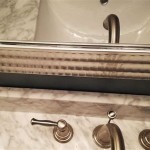Smelly Water From Bathroom Sink: Causes and Solutions
A foul odor emanating from your bathroom sink is an unpleasant experience that can quickly become a source of concern. The smell can be indicative of various underlying issues, ranging from simple clogs to more serious plumbing problems. Identifying the root cause is crucial to effectively address the issue and restore the pleasant environment in your bathroom. This article explores the common culprits behind smelly water from bathroom sinks, providing insights into potential solutions and preventive measures.
1. Clogged Drain
A common culprit behind smelly sink water is a clogged drain. When hair, soap scum, toothpaste, and other debris accumulate in the drainpipe, they create an ideal breeding ground for bacteria. These bacteria decompose organic matter, producing foul-smelling gases. Unpleasant odors can also occur due to the presence of stagnant water within a clogged drain. The water can become contaminated by bacteria, leading to the release of offensive smells.
Addressing a clogged drain involves clearing the obstruction. This can be achieved through various methods, including:
- Using a plunger: A plunger creates suction to dislodge the blockage. It is effective for removing loose clogs but may not work for more stubborn blockages.
- Employing a drain snake: A drain snake is a flexible, coiled tool with a sharp end that can penetrate clogs. It allows you to pull out the blockage from the drainpipe.
- Chemical drain cleaners: Chemical drain cleaners contain strong chemicals that can dissolve clogs. However, their use should be approached with caution due to the potential for damage to plumbing pipes and the risk of hazardous fumes.
2. Trapped Water
Even if your bathroom sink drain appears clear, trapped water in the P-trap can contribute to foul odors. The P-trap is a U-shaped section of pipe beneath the sink. Its purpose is to prevent sewer gases from entering your home. When water evaporates from the P-trap, it leaves behind a space that allows sewer gases to rise, creating a foul smell.
To address trapped water, you can:
- Pour water down the drain: Running water through the drain will refill the P-trap, creating a seal that prevents sewer gases from escaping.
- Check for leaks: A leak in the P-trap can cause water to evaporate, leading to trapped water. Repairing leaks promptly is crucial to prevent the issue from recurring.
3. Sewer Line Problems
In more serious cases, the smelly water from your bathroom sink could be indicative of a problem with the sewer line. A damaged or cracked sewer line can allow sewer gases to escape, leading to foul odors throughout the plumbing system. Other signs of a sewer line issue include slow drains, gurgling sounds in your pipes, and visible sewage backup.
If you suspect a sewer line problem, professional assistance is necessary. A plumbing professional can use specialized equipment to inspect the sewer line and identify the source of the issue. This will allow for appropriate repairs or replacements to address the problem effectively.
4. Vent Stack Issues
The vent stack plays a vital role in maintaining proper air circulation within your plumbing system. It connects your plumbing system to the outside atmosphere, allowing air to enter and exit the pipes as needed. When a vent stack is blocked or damaged, it can disrupt the air flow, leading to sewer gases backing up into your sink. This can result in smelly water and other issues, such as slow drains.
To diagnose potential vent stack issues, a professional plumber will need to inspect the vent stack and associated plumbing components. They can determine if the vent stack is blocked, damaged, or improperly installed. Necessary repairs or replacements can be made to restore proper ventilation and eliminate the odor.
Addressing smelly water from your bathroom sink requires a systematic approach. By identifying the root cause, you can take appropriate steps to rectify the issue and restore the pleasant environment in your bathroom. For complex problems, such as sewer line issues or vent stack problems, it is best to seek the expertise of a qualified plumber.

How To Treat Smelly Water Finkens

Moldy Smelling Water From Bathroom Faucet Hometalk

Cloudy Smelly Or Discoloured Water Quality Help Thames

Smelly Water Could Be A Sign Of Serious Trouble

How To Clean A Stinky Sink Drain Home Repair Tutor

How To Get Rid Of Sink Smell Benjamin Franklin Plumbing
What The Heck In This Ugly Black Stuff My Wife Has Been Complaining About A Nasty Smell Coming From Her Bathroom Sink Since We Moved Into Our New House Two Years Ago

Your Household Water Quality Odors In Uga Cooperative Extension

What Causes Bathroom Drains To Smell
:max_bytes(150000):strip_icc()/__opt__aboutcom__coeus__resources__content_migration__mnn__images__2018__08__sink_drain-351af8e441034f319fe07f00c091d8b6.jpg?strip=all)
How To Clean A Smelly Drain Naturally
Related Posts







